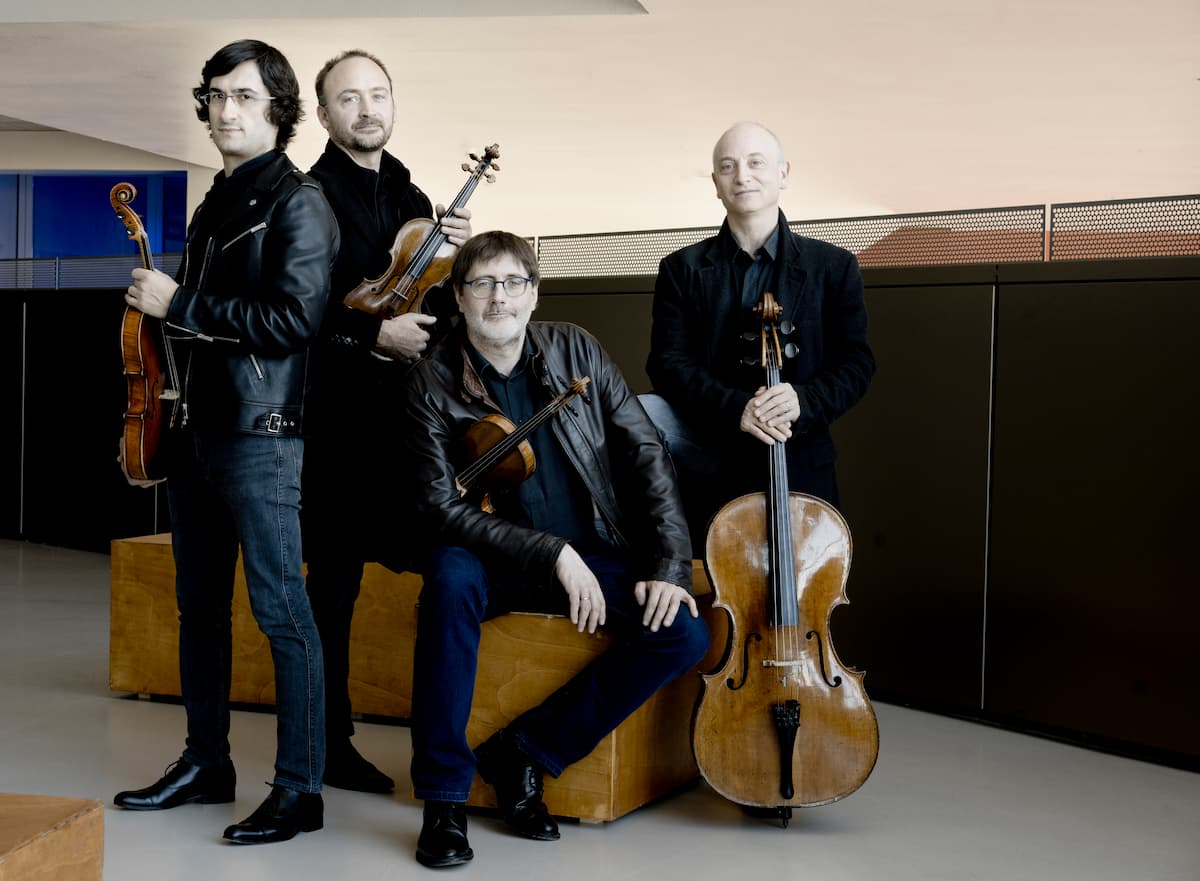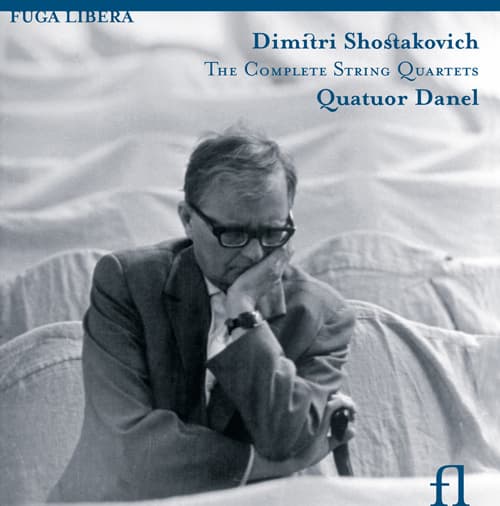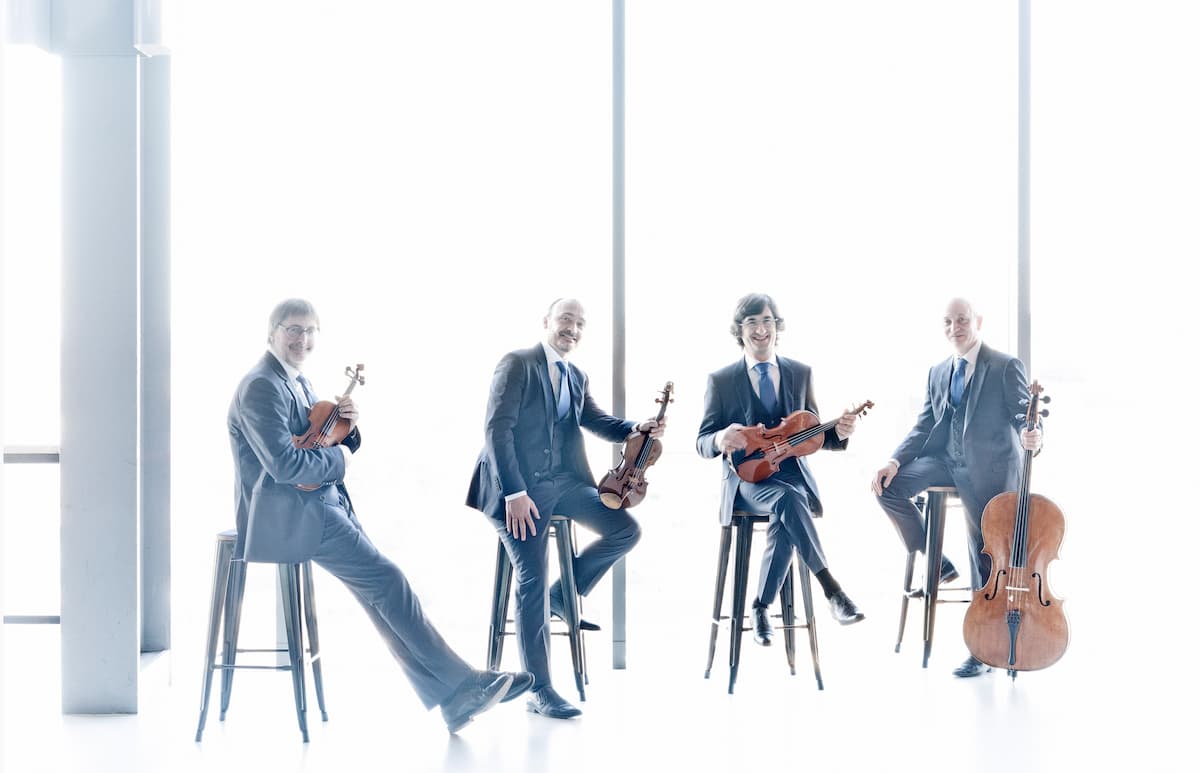The prolific and iconic composer Dmitri Shostakovich was profoundly influenced by the politics of his native country. Despite the Cold War, Soviet ideology, and the restrictions in Russia, he wrote fifteen amazing string quartets full of innovation and exceptional artistry. And even though they are “absolute” music, behind the mask Shostakovich conveys deep meaning, even messages to the listeners. In April of 2024, the complete Shostakovich String Quartets performed by the Belgian quartet Quatuor Danel was released in a newly recorded boxed set on the Accentus Music label. I had a chance to explore the quartet’s intimate and personal connection with these works in a conversation with first violinist Marc Danel.
What drew you four musicians to form a quartet and when were you drawn to the Shostakovich Quartets?

Quatuor Danel © Marco Borggreve
MD: Our work with the Shostakovich string quartets and our own history are closely tied. While studying in Köln, where the Amadeus Quartet was teaching, my sister, brother, and I seized the opportunity to learn from them. We formed our own quartet. In 1990, after playing as an ensemble for about a year and studying at the Music Hochschule in Köln with the Amadeus Quartet, the Borodin Quartet offered a course dedicated to Shostakovich quartets at the Britten-Pears School in Aldeburgh. It was a great prospect for our quartet to explore more of this amazing repertoire. We were thrilled to begin work on No. 13; the first quartet we worked through given that it was the only Shostakovich quartet the Amadeus Quartet had played. The eighth, seventh, and nineth followed. During the course, we received an offer and advice that changed our lives.
Dmitri Shostakovich: String Quartet No. 13 in B-Flat Minor, Op. 138 (Quatuor Danel)
Hugh Maguire, one of the most prominent figures in the development of our career and staunchest supporters, offered the position of quartet in residence for three months in Aldeburgh during the following winter. Invaluable advice then came from Valentin Berlinsky who told us that while he thought we could become a great quartet, we would need to stop everything else to allow that to happen. These two things inspired us to form the Danel Quartet in 1991. The four original members included me, Marc Danel (first violin), Gilles Millet (second violin), Juliette Danel (viola), and Guy Danel (cello). Our decision to become a professional quartet was intertwined with the Shostakovich quartets from the get-go.
Between January and March of 1992, we were invited to perform twelve concerts by the Aldeburgh Foundation, which spurred us to learn more repertoire. As it happened, the Borodin Quartet was in residence in Aldeburgh, and they were willing to offer us their expertise. At this point we’d never played eleven of Shostakovich’s Quartets before, but we decided to play all of them—a feat to learn in three months, but fascinating! The special atmosphere of Aldeburgh enhanced our experience.
I dream of playing the entire Shostakovich cycle in Aldeburgh, where our story began!
Here’s a live performance from 2016. It’s wonderful. You’ve recorded Shostakovich String Quartets complete oeuvre previously. How do you think the new set will differ from your earlier recording?
Danel Quartet Plays Shostakovich’s String Quartet No. 5
MD: The first and most obvious difference is that the initial recording was made in a studio, whereas this new one is a live recording. The underlying philosophy behind each is completely different. In a studio recording, you have a clear vision of what you want to achieve, and you utilize all available resources to realize that vision. A live recording, on the other hand, captures the essence of the moment. When you’re performing on stage in front of an audience, you can’t afford to think about modifying your performance just because it’s being recorded. Whatever might happen, it’s a concert before anything else. You live in the moment.
The idea for a live recording came from our dear friend, promoter, and agent, Peng-Po Hsu from Taiwan. He once said: “I enjoy your recordings, but there’s something extra when you’re performing live on stage!” We took his advice. A live recording represents a snapshot of a unique performance at the exact time it occurred. It’s akin to capturing a moment in history—an approach that brings the experience much closer to attending the actual concert.
Live recordings involve undeniable risks, such as sound quality issues and limited post-production correction options. So, they add an element of danger! The advantages are that live recordings can be done more quickly, and they capture the true essence of our stage presence.
Over the last 15 years a great deal has changed in our interpretation particularly with the works of Shostakovich, who is, in our opinion, one of the greatest composers. Between 1991 and 1996 we did foundational work with the Borodin and Beethoven Quartets. Notwithstanding the immense respect we hold for our teachers, that was a long time ago.
Our style has evolved to reflect more of our own identity. We’ve performed the complete Shostakovich cycle 34 times across the globe and over many years. Our growth and the experiences we’ve accumulated on and off stage, are reflected in our playing and I think we play with more intensity now.
Trailer of the new recording
What specific challenges do you find with the Shostakovich quartets. Is there something that stands out stylistically?
Yovan Markovitch (the cellist) here: In my opinion, the first challenge in the Shostakovich quartets is to discern the specific character and essence of the piece. Shostakovich’s music sometimes appears one could say, simple, “easy” (which happens also of course!) But if we were to play literally, it doesn’t work, as one can risk it becoming “easy going”, perhaps meaningless. Shostakovich often dons a mask. We strive to discover what’s behind the mask.
Another difficulty has to do with sound production. A beautiful sound is not always called for. The romantic approach has dominated our education as string players but to express the right emotion in Shostakovich we might seek a non-romantic approach. Perhaps a more concentrated and resistant sound is in order, with more angular shorter notes, (not round and resonant), which can give the music a stronger character.
Dimitri Shostakovich: String Quartet No. 11 in F Minor, Op. 122 – V. Humoresque: Allegro (Quatuor Danel)

The use of vibrato is also critical. We might choose to use just a small amount of vibrato, or sometimes no vibrato, which can have a powerful effect. Our quartet believes in Shostakovich’s strength and his depth, so we are always seeking to cultivate a specific way of playing that fits his distinct spirit in our opinion!
Shostakovich’s music is transparent, in places like Haydn or Mozart. Music of Schoenberg or Bartók may be more difficult to listen to, as the works are often very complex in term of counterpoint. Perhaps a mistake is less discernible. With Shostakovich, there is no hiding. With countless difficult places for intonation (unisons, fifths), the ensemble must play with extreme accuracy.
The first movement of Quartet No. 15, Elegy, Adagio is a good example. The slow, long notes seem not difficult on the surface but it’s a nightmare for intonation. And to produce a continuous, intense sound, the control of the bow is critical and actually very demanding especially as it is in E-Flat Minor and is 13 minutes long!
Dmitri Shostakovich: String Quartet No. 15 in E-Flat Minor, Op. 144 – I. Elegy: Adagio (Quatuor Danel)
I’m curious about the cello writing as a cellist myself.
YM: Shostakovich truly understood how to write for strings. He was surrounded by amazing string players like Oistrakh, Rostropovich, Kogan, Druzhinin and his colleagues of the Beethoven Quartet, and the Borodin Quartet. I think he had their artistic sound and style in mind.
Perhaps you know Shostakovich was a cellist himself. Shostakovich gives the cello a unique and individual voice, and these are great to play. There are some tricky places though. For example, the demanding fourteenth quartet was written for the brilliant cellist of the Beethoven Quartet, Sergei Shirinsky. Shostakovich uses the entire range of the cello as well as double stops, virtuosic passages, and lyrical themes. The viola is featured too, in the thirteenth. Like for the cello, every quartet has an inspiring viola voice.
Dmitri Shostakovich: String Quartet No. 14 in F-Sharp Major, Op. 142 – I. Allegretto (Quatuor Danel)
How do you keep your interpretation fresh every time you perform them?
MD: Our work with Shostakovich can be equated with a married couple who after 50 years still cherishes their love. We are grateful and look forward to playing this music for as long as we can. With every concert we try to experience these pieces differently each time— to capture the freshness of the first time while focusing on it perhaps being the last. One of my early inspirations was the Amadeus Quartet. I remember my parents drove 150 kilometres so we could hear them play. I was 15 and imagined four distinguished professors, with indisputable knowledge granting us the privilege of listening to them. Instead, I saw four teenagers rushing onto the stage with excitement and joy—an unforgettable image that has stayed with me.
Playing some of the greatest music ever written, whether by Beethoven, Shostakovich, or any iconic composer, is always a privilege, and each performance is a unique opportunity to express something personal. It must come from within, not merely conveying what is written, but also what you want to say at that moment.
I haven’t counted how many times we’ve played a specific piece of music, but we have performed the Shostakovich Quartets the most (we might have played the eighth quartet around 300 times). However, it doesn’t feel like that much! Just as you never tire of gazing at the sea’s beauty, if you love it, each glance feels like a new experience; each performance is an honour and a joy.
It may not be widely known how Shostakovich’s relationship with his native country and the politics of the time contributed to a life of torment. How do you see the effect of this turmoil on his creative journey in the string quartets?

Quatuor Danel © Marco Borggreve
MD: It’s difficult to discern how much of Shostakovich’s music is influenced by his political surroundings and how much stems from other aspects of his life. I tend to believe that politics has an indirect but inevitable effect. Living under Stalin, like Shostakovich did, would certainly have created a heightened state of tension that permeated the life he lived and therefore, what he composed. That said, I prefer not to overly politicize Shostakovich’s message. Although knowing about his circumstances can help recontextualize some of his work, as the situation was indeed extreme, his music, in my view, is universal and humanistic, transcending the specific historical and political context of his time.
I would say there are two notable aspects of Shostakovich’s music. First, there is a pervasive sense of tension. Whether in fast or slow movements, this tension is ever-present, undoubtedly influenced by his life experiences. Nonetheless, his later quartets, which are among his most tragic, were composed during times of personal loss and illness rather than intense political turmoil. Death, a deeply ingrained theme in his work, became more prominent during these periods.
I recall an exhibition of photographs of Shostakovich where he appeared serene and happy, enjoying the company of his pets, and his family and friends. Shostakovich, an avid football fan, like any fan, experienced days of great joy and profound sadness. Reducing his music to mere torment would not be adequate nor representative of Shostakovich’s persona. There is another side to Shostakovich. Quartets like No. 6 and No. 4 contain moments of sheer beauty and tenderness. His compositions are also filled with love, brightness, and even hope, despite the peculiar and pressured historical context in which he lived.
Dimitri Shostakovich: String Quartet No. 6 in G Major, Op. 101 – IV. Lento – Allegretto – Andante (Quatuor Danel)
His music often carries double meanings, beautifully intertwined with an undercurrent of introspection. The third movement of the Quartet No. 8, Allegretto is simultaneously beautiful and frightening, even macabre. We can imagine this complexity reflects a time when people had to be cautious about expressing their true thoughts.
Dimitri Shostakovich: String Quartet No. 8 in C Minor, Op. 110 – III. Allegretto (Quatuor Danel)
Shostakovich’s quartets are profoundly autobiographical. Listening to all fifteen of them is akin to embarking on a journey through the composer’s life. These works open the door to Shostakovich’s deepest realms, and I can say with confidence that the quartets reveal an extraordinary level of beauty.
You performed a series of three concerts at Wigmore Hall in London, and juxtaposed Shostakovich and Weinberg Quartets. In June you performed Shostakovich’s Quartet No. 7 and Weinberg’s Quartet No. 7 and Shostakovich and Weinberg’s 8th Quartets. How fascinating. We can’t wait to listen to your new set of Shostakovich Quartets, and I look forward to discussing the Weinberg Quartets in our next conversation.
For more of the best in classical music, sign up for our E-Newsletter
